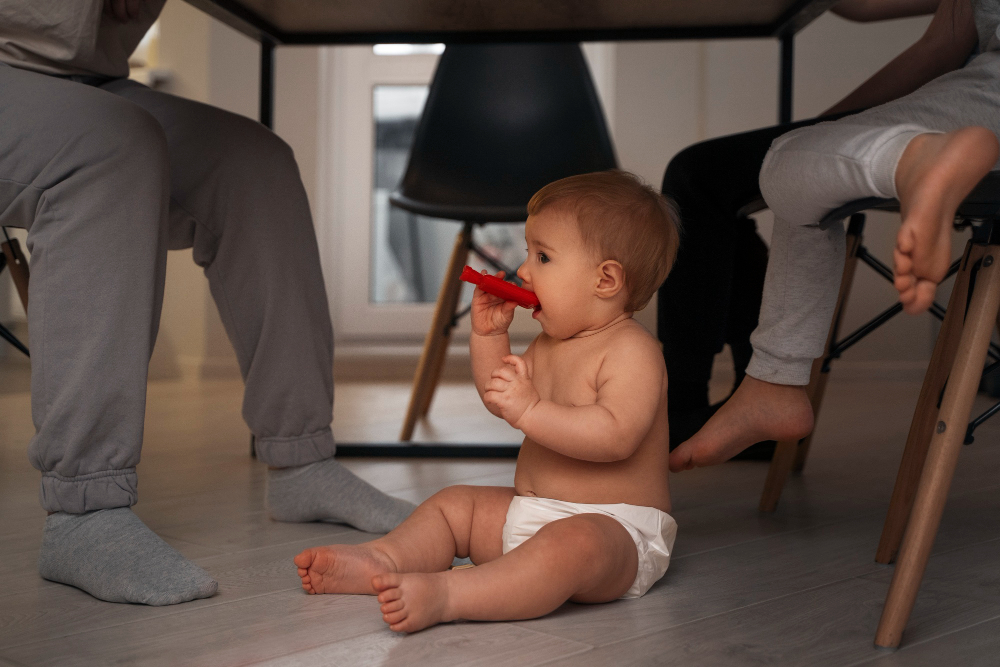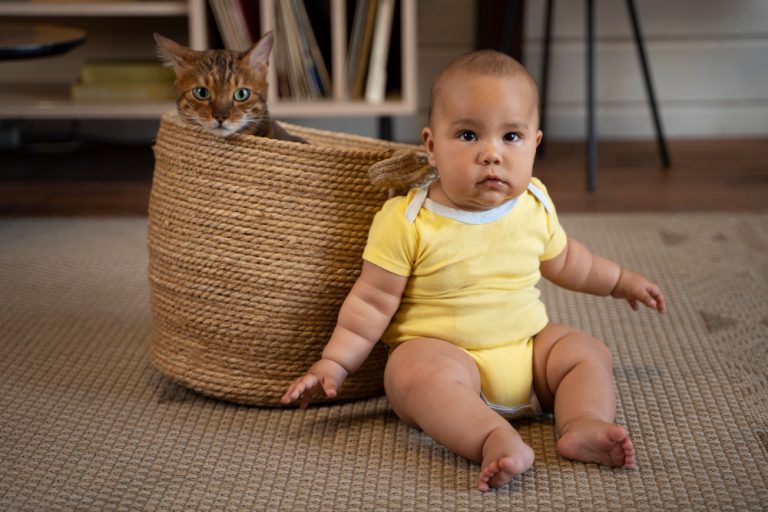When Can Babies Roll From Tummy To Back?
Have you found yourself eagerly watching your little one during tummy time, waiting for that magical moment when they roll over from tummy to back? Do you wonder when can babies roll from tummy to back? The anticipation and joy that come with witnessing your baby hit this developmental milestone are truly priceless – a testament to their growth and progress as they navigate the world around them.
As a parent, nurturing and supporting your baby’s journey towards rolling over is both exciting and fulfilling. Understanding the timeline for when babies typically achieve this feat and knowing how you can play a role in encouraging their success is paramount to their development.
In this blog, we will delve into the fascinating world of baby milestones, focusing on the pivotal moment when can babies roll from tummy to back. From sharing essential tips for facilitating this process to highlighting safety precautions and the next milestones after rolling over, we aim to equip you with the knowledge and confidence to guide your baby through this significant step.
When Can Babies Roll From Tummy To Back?

Babies reaching the milestone of rolling over from tummy to back is an exciting moment for both parents and little ones. While every baby develops at their own pace, there is a typical timeline for when this skill usually emerges.
On average, babies start to roll over between 4 and 6 months of age, but some may begin as early as 3 months, while others may need a little more time and start around 7 months. It’s important to remember that these are just general guidelines, and there is a wide variation among individual babies.
- During the first few months, babies are busy building their neck and back muscles, which are vital for rolling over.
- They gradually gain head control and strength to lift themselves during tummy time.
- As they approach the rolling-over milestone, they may start showing signs of pushing up on their arms and attempting to reach for objects.
Remember, each baby has a unique developmental journey, and there’s no need to be alarmed if your little one has not yet started rolling over. It’s always a good idea to consult with your pediatrician if you have any concerns about when can babies roll from tummy to back.
With patience and encouragement, your baby will soon master the art of rolling over and continue to grow and explore their surroundings.
Signs That Your Baby Is Ready to Roll Over

As your baby grows and develops, there are certain signs that indicate they may be ready to start rolling over from tummy to back. Keep an eye out for these indications:
1. Improved head control
One of the first signs that your baby is getting ready to roll over is better head control. They will be able to hold their head steady and lift it up during tummy time.
2. Pushing up on their arms
During tummy time, your baby may start to push up on their arms to lift their chest off the ground. This is a strong indication that they are building the necessary muscle strength for rolling over.
3. Attempting to reach for objects
You may notice that your baby is actively reaching for toys or objects during playtime. This desire to explore their surroundings and engage with objects is a good sign that rolling over is on the horizon.
Remember, every baby develops at their own pace, so don’t be too concerned if your little one takes a little longer to exhibit these signs. Encourage their development by providing plenty of tummy time opportunities and engaging them with toys and props. With a bit of patience and practice, your baby will soon be rolling over with delight!
How to Help Your Baby Roll Over

Encouraging your baby to roll over from tummy to back is an exciting milestone in their development. By providing the right opportunities and support, you can help your little one master this skill.
Here are some practical tips and techniques to assist your baby in rolling over:
1. Ample Tummy Time
- Tummy time is crucial for building the necessary strength in your baby’s neck, arms, and back muscles.
- Make sure to incorporate plenty of supervised tummy time sessions throughout the day.
- Start with short periods and gradually increase the duration as your baby becomes more comfortable.
2. Use Toys and Props
- Involve colorful toys, rattles, or soft cushions during tummy time to grab your baby’s attention.
- Placing toys slightly out of reach can motivate them to engage their muscles and attempt to roll over.
- These enticing objects can provide the extra motivation your baby needs to try new movements.
3. Gentle Assistance
- While it’s important to let your baby explore and learn at their own pace, gentle assistance can sometimes encourage them to roll over.
- Place your hands on your baby’s back and help guide their movements, supporting them as they transition from tummy to back.
- Be careful not to force or rush the process; let your baby take the lead.
4. Encouraging Sounds and Facial Expressions
- Use your voice and engaging facial expressions during tummy time.
- Talk to your baby, make funny sounds, or use captivating facial expressions to capture their attention and encourage them to explore their movements.
- Your baby’s surprised expression can be an indicator of their determination to master the roll-over skill.
Remember, every baby develops at their own pace, so be patient and supportive. Celebrate each little victory, and avoid comparing your baby’s progress to others.
If you have concerns about your baby’s development, consult with your pediatrician for expert advice.
Helping your baby roll over is an important step towards their physical and cognitive development. By creating a nurturing environment filled with opportunities for exploration and growth, you’ll provide a solid foundation for their future milestones. Enjoy this precious time with your little explorer!
Safety Precautions for Baby Rolling Over

As your baby reaches the exciting milestone of rolling over from tummy to back, it’s crucial to create a safe environment that allows them to explore their newfound mobility. Implementing safety precautions will help protect your little one and give you peace of mind during this developmental phase.
Here are some essential safety measures to consider:
Remove hazards from their sleeping area
- Ensure that your baby’s crib or bassinet is free from any potential dangers.
- Remove stuffed animals, pillows, and thick blankets that may pose a suffocation risk.
- Keep the sleeping surface clean and clutter-free, allowing your baby to move freely and comfortably.
Practice safe sleep practices
- Follow the guidelines from the American Academy of Pediatrics (AAP) to create a safe sleep environment for your baby.
- Place them on their back to sleep on a firm and flat surface.
- Avoid using crib bumpers, loose bedding, or sleep positioners, as these can increase the risk of suffocation or entrapment.
Closely monitor their movements
- As your baby becomes more mobile, it’s important to keep a close watch on them, especially during sleep and playtime.
- Babies can sometimes unintentionally roll into hazardous positions or get trapped between objects.
- Regularly check on your little one and reposition them if needed to ensure their safety.
By taking these safety precautions, you can provide a secure environment for your baby to explore their motor skills and promote their overall well-being. Remember, every baby develops at their own pace, so celebrate their unique journey while keeping their safety a top priority.
Next Developmental Milestones After Rolling Over

After your baby accomplishes the exciting milestone of rolling over from tummy to back, it’s natural to wonder what developmental milestones lie ahead. While every baby develops at their own pace, there are some common milestones that typically follow rolling over.
Here are a few key milestones to look forward to:
Sitting Up
- Sitting up independently is often the next major milestone after rolling over.
- Around the age of six to eight months, your baby will start to develop the core strength and balance necessary to sit without support.
- They may initially need some assistance or use their hands for balance, but as their muscles strengthen, they will gain the ability to sit unaided.
Crawling
- Crawling is an exciting and important milestone in your baby’s development. It usually occurs between seven and ten months of age.
- At first, your baby may use an army-crawl technique or scoot on its belly, but eventually, it will start to crawl on its hands and knees.
- Crawling helps strengthen your baby’s upper body, improve coordination, and prepare it for future mobility.
Standing and Walking
- Once your baby has mastered crawling, they will likely start pulling themselves up to a standing position.
- This typically happens around eight to twelve months of age.
- Supported by furniture or with your assistance, they will begin to explore their surroundings in an upright position.
- Eventually, they will take their first wobbly steps, transitioning from cruising along furniture to independent walking.
It’s important to note that each baby progresses at their own pace, so don’t worry if your little one takes a little longer to reach these milestones. Encourage their development by providing a safe and stimulating environment, plenty of playtime, and opportunities for exploration.
Celebrate each milestone as a new accomplishment and enjoy every step of your baby’s unique developmental journey.
The Final Note: When Can Babies Roll From Tummy To Back
In conclusion, encouraging your baby to roll over from tummy to back is an exciting milestone in their development. Remember that every baby develops at their own pace, so don’t worry if your little one takes a little longer to master this skill.
To support their progress, make sure to provide plenty of tummy time opportunities. This helps strengthen their back muscles and promotes the development of coordination and balance. Use toys and props to motivate your baby during tummy time, encouraging them to reach and explore.
When your baby shows signs of readiness, such as improved head control and attempting to reach for objects, gently assist their movements. Offer a helping hand and guide them from tummy to back, praising their efforts along the way.
Always prioritize safety during this phase. Remove any potential hazards from your baby’s sleeping area and practice safe sleep practices. Keep a close watch on their movements, especially during playtime.
Remember, rolling over is just the beginning! One must not fret about when can babies roll from tummy to back. After your baby starts rolling over, you can look forward to exciting milestones like sitting up, crawling, and walking. Each baby progresses at their own pace, so celebrate and enjoy the unique journey of your little one’s development.
Parenting is an incredible adventure, and witnessing your baby’s growth and milestones is truly a remarkable experience. Cherish every moment and provide a supportive and nurturing environment for your little explorer’s development!







